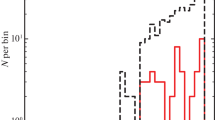Abstract
UBV observations of the X-ray binary system A0535+26/V725 Tau at the Crimean Station of the Sternberg Astronomical Institute in 1980–1998 are presented. Based on our and published data, we analyze the photometric history of the star from 1898. Over a period of 100 years, the star apparently showed all three activity phases (B, Be, Be-shell) of Be stars. We conclude that the X-ray activity of the object is attributable to the 1970–1997 outburst of the Be star due to envelope ejection. The star's colors during the minimum light of 1998 and its 1953–1956 colors (before the outburst) correspond to the spectral type B0–B1 at the color excesses E B-V = 0.74 and E U-B = 0.48, in agreement with the current spectral type O9.7. The minimum light of 1998 and the color excesses are used to determine the colors of the additional radiation, analyze their evolution during the 1973–1997 outburst, and refine the distance to the object (3 kpc). The colors of the additional radiation at maximum light of the star (1973–1980) match the colors of a hydrogen plasma with T e = 1.5 × 104 K which is optically thick in the Balmer continuum. The brightness decline corresponds to a decrease in the optical depth of the plasma; at \(V \simeq 9_.^m 1\), it becomes optically thin in the Balmer continuum with T e = 104 K and N e = 1010 − 1012 cm−3. This conclusion is consistent with the model of a circumstellar envelope but is inconsistent with the existence of an accretion disk around the neutron star. All the additional radiation responsible for the optical variability is produced by a single source. The intensity of the Hα emission line at maximum light (1975–1980) is triple its intensity in 1987–1997, when quasi-periodic light fluctuations with P ≈ 1400d were observed [1]. At this time, the line intensity correlated with brightness. The Hα line was in absorption at the minimum of 1998, and, at present, the star's active phase appears to have ended.
Similar content being viewed by others
References
J. S. Clark, A. E. Tarasov, I. A. Steele, et al., Mon. Not. R. Astron. Soc. 294, 165 (1998).
F. Giovannelli and L.S. Graziati, Space. Sci. Rev. 59, 1 (1992).
A. Giangrande, F. Giovannelli, C. Bartolini, et al., Astron. Astrophys. Suppl. Ser. 40, 289 (1980).
Yu. N. Gnedin, G. V. Zaitseva, V. M. Larionov, et al., Astron. Zh. 65, 1196 (1988).
V. M. Lyutyi, G. V. Zaitseva, and I. D. Latysheva, Pis'ma Astron. Zh. 15, 421 (1989) [Sov. Astron. Lett. 15, 182 (1989)]
H. J. Lamers, Instabilities in Luminous Early Type Stars, Ed. by H. J. Lamers and C. W. de Loore (Reidel, Dordrecht, 1987), p. 99.
J. S. Clark, V. M. Lyutyi, G. V. Zaitseva, et al., Mon. Not. R. Astron. Soc. 302, 167 (1999).
C. Motch, L. Stella, E. Janot-Pacheco, et al., Astrophys. J. 369, 490 (1991).
M. H. Finger, R. B. Wilson, and B. A. Harmon, Astrophys. J. 459, 288 (1996).
F. Lenouvel and C. Flogèr, J. Obs. 40, 1 (1957).
S. Rössiger, Mitt. Ver. Sterne 7, 105 (1976).
S. Rössiger and W. Wenzel, Astron. Nachr. 295, 47 (1974).
C. de Loor, F. Giovannelli, E. L. van Dessel, et al., Astron. Astrophys. 141, 279 (1984).
R. A. Sunyaev and the Kvant Team, IAU Circ. No. 4769 (1989).
W. A. Hiltner, Astrophys. J. Suppl. Ser. 2, 389 (1956).
M. Stier and W. Liller, Astrophys. J. 206, 257 (1976).
S. Rössiger, Die Sterne 55, 76 (1979).
B. Margon, J. Nelson, G. Chanan, et al., Astrophys. J. 216, 811 (1977).
A. Wade and J. B. Oke, Astrophys. J. 215, 568 (1977).
G. B. Baratta, R. Viotti, and A. Altomore, Astron. Astrophys. 65, L21 (1978).
N. F. Voikhanskaya and M. D. Metreveli, Astron. Zh. 56, 450 (1979).
N. F. Voikhanskaya, Pis'ma Astron. Zh. 6, 582 (1980) [Sov. Astron. Lett. 6, 305 (1980)].
O. É. Aab, L. V. Bychkova, I. M. Kopylov, et al., Pis'ma Astron. Zh. 8, 179 (1982) [Sov. Astron. Lett. 8, 94 (1982)].
O. É. Aab, Astron. Zh. 62, 339 (1985).
A. E. Tarasov, Private Communication (1998).
N. N. Chalenko, Astron. Zh. 76, 529 (1999).
N. I. Shakura and R. A. Sunyaev, Astron. Astrophys. 24, 337 (1973).
M. M. Basko and R. A. Sunyaev, Astrophys. Space Sci. 23, 117 (1973).
V. M. Lyutyi and R. A. Sunyaev, Astron. Zh. 53, 511 (1976).
E. K. Sheffer and V. M. Lyutyi, Astron. Zh. 74, 209 (1997).
J. S. Clark, I. A. Steele, M. J. Coe, and P. Roche, Mon. Not. R. Astron. Soc. 297, 657 (1998b).
E. Janot-Pacheco, C. Motch, and M. Mouchet, Astron. Astrophys. 177, 91 (1987).
P. W. Merrill and C. G. Burwell, Astrophys. J. 98, 153 (1943).
W. C. Priedhorsky and J. Terrell, Nature 303, 681 (1983).
S. Rössiger, IAU Circ. No. 3184 (1978).
Author information
Authors and Affiliations
Additional information
__________
Translated from Pis'ma v Astronomicheski\(\overset{\lower0.5em\hbox{$\smash{\scriptscriptstyle\smile}$}}{l} \) Zhurnal, Vol. 26, No. 1, 2000, pp. 13–26.
Original Russian Text Copyright © 2000 by Lyuty, Zaitseva.
Rights and permissions
About this article
Cite this article
Lyuty, V.M., Zaitseva, G.V. One hundred years of observations of the Be star HDE 245770 (the X-ray binary A0535+26/V725 Tau): The end of an active phase?. Astron. Lett. 26, 9–21 (2000). https://doi.org/10.1134/1.20364
Received:
Accepted:
Issue Date:
DOI: https://doi.org/10.1134/1.20364




